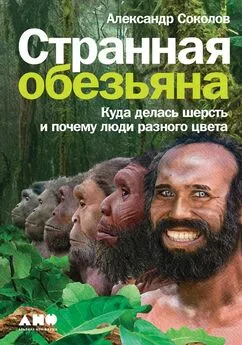Александр Соколов - Странная обезьяна [Куда делась шерсть и почему люди разного цвета]
- Название:Странная обезьяна [Куда делась шерсть и почему люди разного цвета]
- Автор:
- Жанр:
- Издательство:Альпина нон-фикшн
- Год:2020
- Город:Москва
- ISBN:978-5-0013-9316-0
- Рейтинг:
- Избранное:Добавить в избранное
-
Отзывы:
-
Ваша оценка:
Александр Соколов - Странная обезьяна [Куда делась шерсть и почему люди разного цвета] краткое содержание
Об этом и многом другом рассказывает в своей книге редактор портала АНТРОПОГЕНЕЗ.РУ Александр Соколов, еще раз доказывая, что наука — это потрясающе интересно и порой парадоксально.
Странная обезьяна [Куда делась шерсть и почему люди разного цвета] - читать онлайн бесплатно ознакомительный отрывок
Интервал:
Закладка:
22. Carrier D. R. The Energetic Paradox of Human Running and Hominid Evolution // Current Anthropology (Aug — Oct 1984), 25 (4).
23. Kim Allan // Wikipedia. https://en.wikipedia.org/wiki/Kim_Allan.
24. Liebenberg L. Persistence Hunting by Modern Hunter‐Gatherers // Current Anthropology (Dec 2006), 47 (6): 1017–1026.
25. Attenborough D. Human Mammal, Human Hunter // Life of Mammals, BBC. https://www.youtube.com/watch?v=826HMLoiE_o.
26. Liebenberg L. Persistence Hunting by Modern Hunter‐Gatherers // Current Anthropology (Dec 2006), 47 (6): 1017–1026.
Глава 10. Я алгеброй потение поверил
1. Wheeler P. E. The evolution of Bipedality and Loss of Functional Body Hair in Hominids // Journal of Human Evolution (1984), 13: 91–98.
2. Wheeler P. E. The Loss of Functional Body Hair in Man: the Influence of Thermal Environment, Body Form and Bipedality // Journal of Human Evolution (1985), 14: 23–28.
3. Wheeler P. E. The Thermoregulatory Advantages of Hominid Bipedalism in Open Equatorial Environments: the Contribution of Increased Convective Heat Loss and Cutaneous Evaporative Cooling // Journal of Human Evolution (1991), 21: 107–115.
4. Wheeler P. E. The Influence of Bipedalism on the Energy and Water Budgets of Early Hominids // Journal of Human Evolution (1991), 21: 117–136.
5. Wheeler P. E. The Influence of the Loss of Functional Body Hair on the Water Budgets of Early Hominids // Journal of Human Evolution (1992), 23: 379–388.
6. Amaral L. Q., do. Loss of Body Hair, Bipedality and Thermoregulation. Comments on Recent Papers in the Journal of Human Evolution // Journal of Human Evolution (1996), 30: 357–366.
7. Wheeler P. E. The Environmental Context of Functional Body Hair Loss in Hominids (A Reply to Amaral, 1996) // Journal of Human Evolution (1996), 30: 367–371.
8. Ruxton G. D. and Wilkinson D. M. Avoidance of Overheating and Selection for Both Hair Loss and Bipedality in Hominins // PNAS (Dec 2011), 108 (52): 20965–20969.
9. Ruxton and Wilkinson. Supporting Information 10.1073/pnas.1113915108 // PNAS (Dec 2011), 108 (52): 20965–20969.
10. Dávid-Barrett T. Bipedality and Hair Loss in Human Evolution Revisited: The Impact of Altitude and Activity Scheduling // Journal of Human Evolution (May 2016), 94: 72–82.
11. Бахр-эль-Газаль / Chad = Bahr el Ghazal = Koro Toro // АНТРОПОГЕНЕЗ.РУ. Каталог находок. http://antropogenez.ru/location/33/.
Глава 11. Бритва Амура
1. Darwin C. The Descent of Man, and Selection in Relation to Sex. New York: D. Appleton and Company, 1889, p. 58.
2. Montacna W. The Skin of Nonhuman Primates // American Zoologist (1972), 12: 109–124.
3. Stephenson W. The Ecological Development of Man. Sydney: Angus and Robertson, 1972.
4. Чангизи М. Революция в зрении. — М.: АСТ, 2015.
5. Там же.
6. Там же.
7. Barber N. The Evolutionary Psychology of Physical Attractiveness: Sexual Selection and Human Morphology // Ethology and Sociobiology (1995), 16: 395–424.
8. Puts D. A. Beauty and the Beast: Mechanisms of Sexual Selection in Humans // Evolution and Human Behavior (2010), 31: 157–175.
9. Giles J. Naked Love: The Evolution of Human Hairlessness // Biological Theory (2010), 5 (4): 326–336.
10. Cantrill R. M. Influence of Naked Body Contact between Mother and Newborn on Effective Breastfeeding // Thesis (PhD Doctorate), 2007. https://research-repository.griffith.edu.au/handle/10072/367422.
11. Harlow H. F., Zimmermann R. R. The Development of Affectional Responses in Infant Monkeys // Proceedings of the American Philosophical Society (1958), 102: 501–509.
12. Harris J. R. Parental Selection: A Third Selection Process in the Evolution of Human Hairlessness and Skin Color // Medical Hypotheses (2006), 66: 1053–1059.
Глава 12. Мой ласковый мохнатый зверь
1. Basow S. A., Braman A. C. Women and Body Hair. Social Perceptions and Attitudes // Psychology of Women Quarterly (Dec 1998), 22 (4): 637–645. https://onlinelibrary.wiley.com/doi/abs/10.1111/j.1471–6402.1998.tb00182.x.
2. Tiggemann M., Lewis C. Attitudes toward Women’s Body Hair: Relationship with Disgust Sensitivity // Psychology of Women Quarterly (2004), 28 (4).
3. Toerien M., Wilkinson S. Gender and Body Hair: Constructing the Feminine Woman // Women’s Studies International Forum (July — Aug 2003), 26 (4): 333–344.
4. Toerien M., Wilkinson S. and Choi P. Y. L. Body Hair Removal: The ‘Mundane’ Production of Normative Femininity // Sex Roles (2005), 52: 399–406.
5. Tiggemann M. & Kenyon S. J. The Hairlessness Norm: The Removal of Body Hair in Women // Sex Roles (1998), 39: 873–885.
6. Tiggemann M. & Hodgson S. The Hairlessness Norm Extended: Reasons for and Predictors of Women’s Body Hair Removal at Different Body Sites // Sex Roles (2008), 59: 889–897.
7. Toerien M., Wilkinson S. Gender and Body Hair: Constructing the Feminine Woman // Women’s Studies International Forum (July — Aug 2003), 26 (4): 333–344.
8. Toerien M., Wilkinson S. and Choi P. Y. L. Body Hair Removal: The ‘Mundane’ Production of Normative Femininity // Sex Roles (2005), 52: 399–406.
9. Boroughs M., Cafri G., and Thompson J. K. Male Body Depilation: Prevalence and Associated Features of Body Hair Removal // Sex Roles (May 2005), 52 (9/10).
10. Verinis J. S and Roll S. Primary and Secondary Male Characteristics: The Hairiness and Large Penis Stereotypes // Psychological Reports (1970), 26: 123–126.
11. Boroughs M., Cafri G., and Thompson J. K. Male Body Depilation: Prevalence and Associated Features of Body Hair Removal // Sex Roles (May 2005), 52 (9/10).
12. Boroughs M. and Thompson J. K. Body Depilation in Males: A New Body Image Concern? // International Journal of Men’s Health (Sept 2002), 1 (3): 247–257.
13. Dixson A. and others. Masculine Somatotype and Hirsuteness as Determinants of Sexual Attractiveness to Women // Archives of Sexual Behavior (Mar 2003).
14. Dixson B. J., Dixson A. F., Li B., and Anderson M. J. Studies of Human Physique and Sexual Attractiveness: Sexual Preferences of Men and Women in China // American Journal of Human Biology (2017), 19: 88–95.
15. Dixson B. J., Dixson A. F., Morgan B., Anderson M. J. Human Physique and Sexual Attractiveness: Sexual Preferences of Men and Women in Bakossiland, Cameroon // Archives of Sexual Behavavior (2007), 36: 369–375.
16. Prokop P., Rantala M. J., Usak M., Senay I. Is a Woman’s Preference for Chest Hair in Men Influenced by Parasite Threat? // Archives of Sexual Behavior. (2013), 42: 1181–1189.
17. Dixson B. J., Dixson A. F., Bishop P. J. & Parish A. Human Physique and Sexual Attractiveness in Men and Women: A New Zealand-U. S. Comparative Study // Archives of Sexual Behavior (2010), 39: 798–806.
18. Penton-Voak I. S., Perrett D. I., Castles D. L., Kobayashi T., Burt D. M., Murray L. K., Minamisawa R. Menstrual Cycle Alters Face Preference // Nature (June 1999), Vol. 399.
19. Rantala M. J., Pölkki M., Rantala L. M. Preference for Human Male Body Hair Changes Across the Menstrual Cycle and Menopause // Behavioral Ecology (Mar. — Apr. 2010), 21 (2): 419–423.
20. Winkler E.-M., Christiansen K. Sex Hormone Levels and Body Hair Growth in! Kung San and Kavango Men from Namibia // American Journal of Physical Anthropology (Oct 1993), 92 (2): 155–164.
Глава 13. Не трогай волосы
1. Epstein F. H., Editor, Paus R., and Cotsarelis G. The Biology of Hair Follicles // New England Journal of Medicine (Nov 1999), Vol. 341.
2. Hamalainen H. A., Warren S. & Gardner E. P. Differential Sensitivity to Airpuffs on Human Hairy and Glabrous Skin // Somatosensory Research (1985), 2: 4, 281–302.
3. Там же.
4. Dean I. and. Siva-Jothy M. T. Human Fine Body Hair Enhances Ectoparasite Detection // Biology Letters (2012), 8: 358–361.
Глава 14. Слоны не потеют
1. Wright P. G. & Luck C. P. Do Elephants Need to Sweat? // South African Journal of Zoology (1984), 19 (4): 270–274. https://journals.plos.org/plosone/article?id=10.1371/journal.pone.0047018#pone.0047018-Wright2.
2. Myhrvold C. L, Stone H. A, Bou-Zeid E. What Is the Use of Elephant Hair? // PLoS One (2012), 7 (10), e47018.
3. Marett J. R. de la H. Race, Sex, and Environment: A Study of Mineral Deficiency in Human Evolution // Hutchinson’s Scientific and Technical Publications , 1936.
4. Stephenson W. The Ecological Development of Man. Sydney: Angus and Robertson, 1972.
5. Pobiner B. L. New Actualistic Data on the Ecology and Energetics of Hominin Scavenging Opportunities // Journal of Human Evolution (Mar 2015), 80: 1–16.
6. Shizuyo S. Hairless Mutation: A Driving Force of Humanization from a Human-Ape Common Ancestor by Enforcing Upright Walking While Holding a Baby with Both Hands // Genes to Cells (2012), 17: 264–272.
7. Shizuyo S. The Hairless Mutation Hypothesis Explains Not Only the Origin of Humanization from the Human. Ape Common Ancestor but also Immature Baby Delivery // Human Genet Embryol (2013), 3: 2.
8. Denda M., Menon G., and Elias P. M. Did Hairlessness Stimulate an Increase in Hominin Brain Size? Insights from the Cutaneous Neurosensory Interface and Comparative Vertebrate Morphology // Anthropol (2018), 6: 1.
9. Nilsson G. Brain and Body Oxygen Requirements of Gnathonemus Petersii, a Fish with an Exceptionally Large Brain // Journal of Experimental Biology (1996), 199 (Pt 3): 603–7.
10. Kverková K., Olkowicz S., Pavelkova Z., Šumbera R., Burda H., Bennett N., Němec P. Sociality Does not Drive the Evolution of Large Brains in Eusocial African Mole Rats // Scientific Reports (June 2018), 8 (9203).
Читать дальшеИнтервал:
Закладка:
![Обложка книги Александр Соколов - Странная обезьяна [Куда делась шерсть и почему люди разного цвета]](/books/1066936/aleksandr-sokolov-strannaya-obezyana-kuda-delas-sh.webp)






